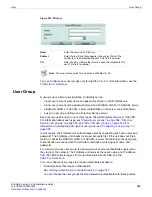
Local user accounts
User
FortiGate Version 4.0 Administration Guide
568
01-400-89802-20090424
You can configure your FortiGate unit to authenticate system administrators with your
FortiGate unit, using RADIUS, LDAP and servers and with certificate-based
authentication using PKI. For more information, see
. You
can change the authentication timeout value or select the protocol supported for Firewall
authentication. For more information, see
. You can view lists of
currently authenticated users, active SSL VPN sessions, activity on VPN IPSec tunnels,
authenticated IM users, and banned users. For more information, see
For each network resource that requires authentication, you specify which user groups are
permitted access to the network. There are three types of user groups: Firewall, Directory
Service, and SSL VPN. For more information, see
“Firewall user groups” on page 584
,
“Directory Service user groups” on page 585
“SSL VPN user groups” on page 585
Local user accounts
A local user is a user configured on a FortiGate unit. The user can be authenticated with a
password stored on the FortiGate unit (the user name and password must match a user
account stored on the FortiGate unit) or with a password stored on an authentication
server (the user name must match a user account stored on the FortiGate unit and the
user name and password must match a user account stored on the authentication server
associated with the user).
Instant Messenger (IM) protocols are gaining in popularity as an essential way to
communicate between two or more individuals in real time. Some companies even rely on
IM protocols for critical business applications such as Customer/Technical Support.
The most common IM protocols in use today include AOL Instant Messenger, Yahoo
Instant Messenger, MSN messenger, and ICQ. FortiGate units allow you to set up IM
users that either allow or block the use of applications, to determine which applications are
allowed.
Configuring Local user accounts
You can block a user with a valid local user account from authenticating at all, or configure
the FortiGate unit to allow a user to authenticate with a user name and password stored
on the FortiGate unit, or with an account stored on a specific server (LDAP, RADIUS, or
).
To view the list of existing local users, go to
User > Local.
Figure 372: Example Local user list
Create New
Add a new local user account.
User Name
The local user name.
Edit
Delete
Summary of Contents for Gate 60D
Page 705: ...www fortinet com...
Page 706: ...www fortinet com...































